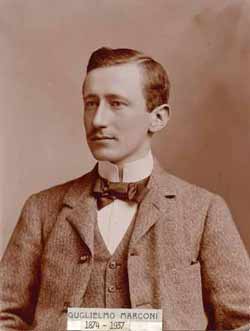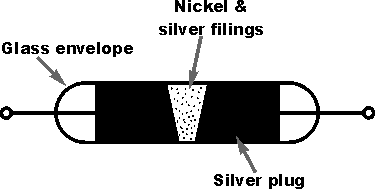Guglielmo Marconi - short biography of his life
A biography of the life and history of Guglielmo Marconi, father of radio or wireless, with facts about his work and quotes of things he said.
Guglielmo Marconi Biography Includes:
Guglielmo Marconi
Spanning the Atlantic
Technology developments
Last days
Facts & quotes
Guglielemo Marconi is often called the "Father of Radio" for the many developments he made to radio, and although he probably did more than any other person to advance radio technology, he freely admitted that he did not invent it.
However Marconi left behind a great legacy, his biography shows that he pushed forward radio technology in a way that nobody else did. He achieved milestones that nobody thought possible at the time. Many thought his ideas were too far-fetched and could never be achieved.
In fact the whole of Marconi's life was full. Although he was not a theoretical scientist he had a very inventive mind. He also never let the obstacles that stopped others, prevent him from reaching his goal. It was these qualities that enabled him to achieve greatness, and receive his rightful place in history.

Guglielmo Marconi in 1901
Courtesy Marconi plc
Marconi's childhood
Guglielmo Marconi was born on 25th April 1874 in Bologna in Northern Italy.
Marconi's, father, Guiseppe, was a widower and wealthy Italian. His mother came from a Scottish and Irish family of brewers and distillers, and she ran away from home to marry him.
Marconi's mother loved to travel and the young Guglielmo accompanied her on many of her trips. As a result the young Marconi received private tuition, this gave him further insight into some of the fundamental concepts he would require later. He later attended a school in Florence, but found his work difficult. Nevertheless Marconi still managed to progress to the Technical Institute of Leghorn where he was more successful, and developed an interest in physics.
Unfortunately Marconi left the Institute without any formal qualifications. This displeased his father, but despite this he returned home and continued to perform various scientific experiments.
Marconi's mother was very loyal to her son, and she arranged that one of their neighbours, a noted physicist named Professor Righi acted as an adviser. It was through this contact that Marconi's interest became focused on the newly discovered radio or Hertzian Waves.
Marconi's wireless experiments
With Marconi's interest fired with ideas of Hertzian Waves. He started by repeating the experiments of Heinrich Hertz who had discovered their existence. These experiments used a spark in a transmitting circuit to induce a second but smaller spark in a receiving circuit placed a short distance away.
Like Hertz he only managed to achieve ranges of a few metres. Later he managed to improve the distance over which the spark could be detected by using a device called a coherer in the receiver. A Frenchman named Edouard Branly was the first to observe the effect behind the coherer and this was later improved and popularised by Oliver Lodge in its use for detecting Hertzian wave transmissions.
Marconi realised that the sensitivity of the coherer was crucial to the range that could be achieved. As a result he set about trying to improve its sensitivity. At this time the way in which the coherer operated was not understood, and so Marconi set about improving it by trial and error. His experiments lead to a much improved device which used 95% nickel filings and 5% silver filings in an evacuated tube.

Coherer as used by Marconi
Marconi did not restrict his activities to the investigations of the coherer, he looked beyond this as well. He discovered that by using an antenna consisting of a combination of an earth and a vertical conductor, significant improvements in the signal strength could be made. This enabled him to increase the range of his transmissions even further. In one experiment he performed Marconi operated the transmitter in the house whilst the receiver was taken into the fields. Confirmation of a signal was indicated by the operator waving a white handkerchief. However when the receiver was taken over a hill the report from a hunting rifle had to be used.
Eventually Marconi was able to detect signals at distances up to about two kilometres. Realising the possibilities this offered for communications, he offered the idea to the Italian authorities. Unfortunately they were not impressed and they dismissed the idea.
Move
History shows that Guglielmo Marconi was not deterred by his rejection, but in order to be able to exploit his idea he moved to England with his mother in February 1896.
On their arrival, Marconi and his mother were met by his cousin, Henry Jameson-Davies. He was an engineer himself, and gave the young Marconi an introduction to A.A. Campbell Swinton, Scottish consulting electrical engineer who was interested in communications and had been following some of the experiments performed by Hertz. As a result he had some connections who were of use to Marconi, introducing him to William Preece the Chief Engineer of the Post Office. Preece was keenly interested in wire-less forms of communications and had performed a number of wireless experiments himself.
Following up on his new introduction, Marconi undertook a number of demonstrations. The first was set up on the rooftops of two buildings in London in July of that year. Communication was successfully made over a distance of a few hundred yards. This impressed all that were present, especially because there were buildings in the line of transmission, and wire-less communication was still very new and a great novelty.
As a result of the success of the first demonstration a further test was requested on Salisbury Plain at the beginning of September. This time representatives from the War Office and the Admiralty were also present. In view of the additional observers, Marconi used parabolic reflectors at the transmitter and receiver to show the directional properties of the waves. This was important to show that secrecy could be maintained during transmissions. The use of this technology limited the range to only about two and a half kilometres. Further tests six months later used balloons to raise the height of more conventional antennas. This time a range of over seven kilometres was achieved.
The next demonstration was made to the press. This was very successful, partly because of the novelty of being able to communicate electrically without any intervening wires. The effect was also enhanced by the showmanship used in the performance as both transmitter and receiver were housed in black boxes. As a result Marconi became an instant celebrity.
Up until this time the new Hertzian or radio waves used by Marconi had not been put to any real use. Then in 1897 it was decided to test the new system and see if it could provide a reliable link across various stretches of water. If this were successful it would save on the installation of expensive submarine cables. In some of the first of these tests across the Bristol Channel, Marconi's system proved to be very successful, further enhancing his image.
Marconi opens for business
With the success of these tests interest in the possible uses of radio grew, and in July 1897 Marconi decided that he had to launch his own company. Named the "Wireless Telegraph and Signal Company Limited" its foundation allowed him to borrow further money to allow further tests and development to be performed. With financial backing behind him he continued his developments and tests.
Little was still understood about Wireless or Hertzian waves and therefore further tests were needed. In late 1897 Marconi erected masts over 40 metres high outside the Needles Hotel on the Isle of Wight. From here he made transmissions which he received on a boat which steamed up and down the Solent to test reception over the sea. From this site he managed to achieve a range of over 30 kilometres and also confirmed that transmissions could be reliably made over water. As evidence of this anyone visiting the Needles today can see a plaque in the car park commemorating the site of these transmissions.
With these further increases in range it was decided to attempt to make the first international radio link by transmitting across the English Channel. To achieve this, masts were set up at South Foreland and at Wimereux near Boulogne and the first successful international wireless transmissions were made in 1899. In view of its importance this test received a large amount of press coverage, and was very successful. However it also enabled new discoveries to be made because the transmissions were picked up over 130 kilometres away in Chelmsford. This discovery was very significant because until this time it was only thought that transmissions could be made over line of sight paths.
The same year brought another success for Marconi. He received his first order from the British Navy. Up until this time he had spent large sums of money on research, but had received very few orders. If his company was to survive, then he needed more orders of this nature.
More Famous Scientists in Electronics and Radio:
Volta
Ampere
Armstrong
Appleton
Babbage
Bardeen
Brattain
Edison
Faraday
R A Fessenden
Fleming
Heaviside
Hertz
Ohm
Oersted
Gauss
Hedy Lamarr
Lodge
Marconi
Maxwell
Morse
H J Round
Shockley
Tesla
Return to History menu . . .


